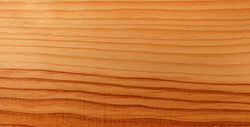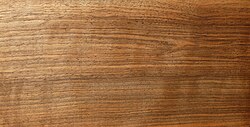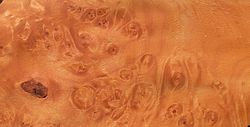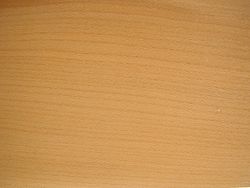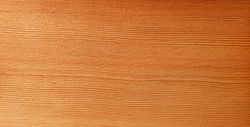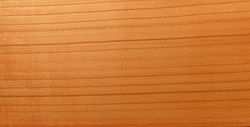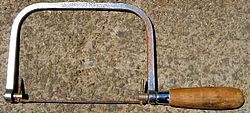Difference between revisions of "AY Honors/Wood Handicraft/Answer Key"
m (Transwiki:Pyrography moved to AY Honor Wood Handicraft: transwiki import) |
|||
| Line 1: | Line 1: | ||
| − | {{ | + | {{honor_header|2|1938|Arts and Crafts|General Conference}} |
| − | '' | + | ==1. Identify at least five common kinds of wood, such as pine, walnut, oak, and cedar. == |
| + | Precise identification of wood samples can be very difficult indeed, especially when one considers how ''many'' different types of wood there are. For this requirement, it will suffice to bring in five samples and teach the student to distinguish between them. Unless you are already an expert at identifying wood, you would be well served to visit a specialty lumber establishment and ask for a few samples of five species. These types of stores are staffed by extremely knowledgeable people. You may also have luck at a hardware/lumber store such as Lowes or Home Depot. These store will often display their hardwoods in a different section from construction lumber (which is mostly fir and pine). They commonly carry oak, maple, and poplar lumber, and less commonly, cedar. Beech, oak, and luan (a cheap grade of mahogany) are usually available in plywood form. You may also be able to get free samples at a hardwood floor store. | ||
| − | + | When you have your samples, label them on one side so you can be sure of their identities. | |
| − | + | ===Pine=== | |
| + | [[Image:Kiefer Holz.JPG|thumb|250px|Pine]] | ||
| + | Pines is among the most commercially important genus of tree, valued for its timber and wood pulp throughout the world. Pine wood is widely used in high-value carpentry items such as furniture, window frames, paneling and floors. Pine is readily available at commercial lumberyards, being among the least expensive forms of lumber. Pine is light yellow to white with a reddish tinge. It darkens to an orange tint with age. The wood is soft and easily shaped with both hand and power tools, making it a very popular choice for wood craft. | ||
| + | <br style="clear:both"> | ||
| + | ===Walnut=== | ||
| + | [[Image:Nussbaum Holz.JPG|thumb|250px|Walnut]] | ||
| + | The Persian Walnut, and the Black Walnut and its allies, are important for their attractive timber, which is hard, dense, tight-grained and polishes to a very smooth finish. The colour ranges from creamy white in the sapwood to a dark chocolate colour in the heartwood. When kiln-dried, walnut wood tends toward a dull brown colour, but when air-dried can become a rich purplish-brown. Because of its colour, hardness and grain it is a prized furniture and carving wood. Walnut burls (or 'burrs' in Europe) are commonly used to create bowls and other turned pieces. Veneer sliced from walnut burl is one of the most valuable and highly prized by cabinet makers and prestige car manufacturers. | ||
| − | + | Walnut is an expensive lumber not usually available at the usual lumberyards (Home Depot, Lowes, etc). One generally has to buy it at a specialty hardwood lumber store. | |
| + | <br style="clear:both"> | ||
| + | ===Oak=== | ||
| + | [[Image:Traubeneiche.jpg|thumb|250px|Oak]] | ||
| + | Oak has very attractive grain markings, particularly when quarter-sawn. Wide, quarter-sawn boards of oak have been prized since the Middle Ages for use in interior paneling of prestigious buildings such as the debating chamber of the British House of Commons in London, England, and in the construction of fine furniture. Today oakwood is still commonly used for furniture making and flooring, timber frame buildings, and for veneer production. | ||
| − | + | Oak is a very hard, strong, and durable wood. It is not easily worked when cured, and is thus not a good choice for the beginning wood crafter. However, in the hands of a skilled craftsman, it is an excellent choice, holding carving detail well over very long periods of time. | |
| + | <br style="clear:both"> | ||
| − | == | + | ===Cedar=== |
| − | The | + | The fine-grained, soft brittle pinkish- to brownish-red heartwood is fragrant, very light and very durable, even in contact with soil. Because of its rot resistance the wood is used for fence posts. Because the aromatic wood is avoided by moths it is in demand as lining for clothes chests and closets, often referred to as cedar closets and cedar chests. It was once a premier wood for pencils. |
| − | |||
| − | |||
| − | |||
| − | |||
| − | |||
| − | + | Cedar is available at some lumberyards, but is often located in a section of the store reserved for outfitting closets. It is more expensive than pine, but not out of reach of the budget-conscious Pathfinder. Its aroma alone make it well worth the added expense compared to pine, and it works just as easily. It is an excellent choice for the beginner. | |
| − | + | <br style="clear:both"> | |
| − | |||
| − | |||
| − | |||
| − | |||
| − | |||
| − | |||
| − | |||
| − | |||
| − | |||
| − | [[ | + | ===Maple=== |
| − | [[ | + | [[Image:Ahorn-Maser Holz.JPG|thumb|250px|left|Maple with Birdseye Figure]] |
| + | [[Image:Ahorn Holz.JPG|thumb|250px|right|Maple with straight grain]] | ||
| + | Some of the larger maple species have valuable timber, particularly Sugar Maple in North America, and Sycamore Maple in Europe. Sugar Maple wood, often known as "hard maple", is the wood of choice for bowling pins, bowling alley lanes, pool cue shafts, drums, and butcher's blocks. Maple wood is also used for the production of wooden baseball bats, though less often than ash or hickory. | ||
| − | [[ | + | Some maple wood has a highly decorative wood grain, known as flame maple and quilt maple. This condition occurs randomly in individual trees of several species, and often cannot be detected until the wood has been sawn, though it is sometimes visible in the standing tree as a rippled pattern in the bark. |
| + | |||
| + | Maple is a very hard wood, and while that makes it difficult to work with hand tools, it also makes it a very good choice when fine carving details are desired. Because of its working difficulty, it is a wood better left to the experienced craftsman rather than the beginner. | ||
| + | <br style="clear:both"> | ||
| + | |||
| + | ===Fir=== | ||
| + | [[Image:Douglasie Holz.JPG|thumb|250px|Fir]] | ||
| + | Douglas-fir wood is used for structural applications that are required to withstand high loads. It is used extensively in the construction industry. Like pine and cedar, it is a soft, easily worked wood. | ||
| + | <br style="clear:both"> | ||
| + | |||
| + | ===Cherry=== | ||
| + | [[Image:Kirschbaum Holz.JPG|thumb|250px|Cherry]] | ||
| + | Cherry is a beautiful wood highly prized for furniture making. It has a warm brown tone that changes with age to a dark reddish brown. Cherry holds carving details well as it is a hardwood, but it is easier to work than oak, ash, walnut, or maple. Cherry is unlikely to be found in most hardwood/lumber stores, but it is readily available at specialty hardwood outlets. Cherry takes a finish like almost no other wood, providing a rich luster that takes a high polish. | ||
| + | <br style="clear:both"> | ||
| + | |||
| + | ==2. Know the characteristics for the woods identified, and know one use for each example. == | ||
| + | The characteristics of each of these woods are described in requirement 1. We list common uses of each below: | ||
| + | ;Pine: Furniture, shelving, flooring | ||
| + | ;Walnut: Furniture, paneling | ||
| + | ;Oak: Furniture, decorative trim (chair rail, molding, stair rails), paneling, beams, flooring, barrels | ||
| + | ;Cedar: Closets, storage chests, plaques | ||
| + | ;Maple: Furniture, flooring, musical instruments (guitars, violins, drums, etc), butcher blocks | ||
| + | ;Fir: Construction | ||
| + | ;Cherry: Furniture | ||
| + | |||
| + | ==3. What is the difference between hard and soft wood? == | ||
| + | Wood that is produced by cone-bearing trees is classified as softwood. All other wood is classified as hardwood. In general hardwoods are harder than softwoods, but there are many hard softwoods (such as yellow pine and yew), and there are many soft hardwoods (such as balsa). The hardness of the wood is therefore not a reliable indicator of whether a wood is a hardwood or a softwood. | ||
| + | |||
| + | ==4. Know how to properly use the following tools in wood handicrafts: == | ||
| + | ===a. Coping saw === | ||
| + | {{:Adventist Youth Honors Answer Book/Woodworking Tools/Coping saw}} | ||
| + | ===b. Rasp === | ||
| + | {{:Adventist Youth Honors Answer Book/Woodworking Tools/Rasp}} | ||
| + | ===c. Plane === | ||
| + | {{:Adventist Youth Honors Answer Book/Woodworking Tools/Plane}} | ||
| + | ===d. Knife === | ||
| + | {{:Adventist Youth Honors Answer Book/Woodworking Tools/Knife}} | ||
| + | ===e. Chisel === | ||
| + | {{:Adventist Youth Honors Answer Book/Woodworking Tools/Chisel}} | ||
| + | ===f. Sanding block=== | ||
| + | {{:Adventist Youth Honors Answer Book/Woodworking Tools/Sanding Block}} | ||
| + | |||
| + | ==5. Know at least two safety procedures for each of the above tools. == | ||
| + | The main safety rule to follow with any tool is to ''use common sense''. | ||
| + | ===Coping saw=== | ||
| + | # Clamp your work firmly to a bench before cutting it with a coping saw. You may wish to pad the clamp with a piece of scrap wood so it does not mar the piece. | ||
| + | # Be careful not to saw into the bench. | ||
| + | # Keep your fingers clear of the blade. | ||
| + | ===Rasp=== | ||
| + | # Do not draw the rasp across your skin - it will cut skin even easier than it will cut wood. | ||
| + | # Do not strike a rasp with a hammer or mallet or it may shatter. | ||
| + | ===Plane=== | ||
| + | # Do not test the sharpness of a plane's blade by sliding it along a finger. | ||
| + | # Retract the plane blade when storing. | ||
| + | # Keep the blade sharp. | ||
| + | ===Knife=== | ||
| + | # Do not push the knife toward another person (or yourself!) when cutting. Imagine the path blade will follow if the item you are cutting suddenly give way, freeing the blade. Always make sure nothing is in that path. | ||
| + | # If you drop a knife, let it fall. Do not try to catch it. | ||
| + | # When handing a knife to another person, offer them the handle - not the blade. | ||
| + | # Do not throw the knife. | ||
| + | # Do not use a locking knife unless the blade is locked. | ||
| + | # For non-locking knives that fold, be aware that it may close on your hand if you apply pressure the wrong way. | ||
| + | # Do not pry with a knife - you may break the blade. | ||
| + | # Keep the blade sharp. | ||
| + | ===Chisel=== | ||
| + | # Store the chisel with the blade covered. | ||
| + | # Keep the blade sharp. | ||
| + | # Keep both hands behind the blade. | ||
| + | # Use a mallet with the chisel rather than pushing it along with your hand. This will ensure that your hands ''are'' both behind the blade. | ||
| + | # Do not put a chisel in your pocket. | ||
| + | ===Sanding block=== | ||
| + | # Do not throw a sanding block | ||
| + | # Pay attention to the path of the sanding block. It is easy to knock something over when you're paying attention to the piece you're sanding instead of the surrounding environment. | ||
| + | # Do not sand skin. Sand paper ''will'' abraid skin. | ||
| + | |||
| + | ==6. Cut out, assemble, and finish animal bookends or doorstop. == | ||
| + | ==7. Cut out and finish a garden stake or lawn marker, using a design such as a child, bird, flower, or tree. == | ||
| + | ==8. Make a plaque, tray, notebook cover, or some other useful object in which wood burning is used.== | ||
| + | |||
| + | [[Category:Adventist Youth Honors Answer Book|{{SUBPAGENAME}}]] | ||
Revision as of 01:05, 7 February 2008
1. Identify at least five common kinds of wood, such as pine, walnut, oak, and cedar.
Precise identification of wood samples can be very difficult indeed, especially when one considers how many different types of wood there are. For this requirement, it will suffice to bring in five samples and teach the student to distinguish between them. Unless you are already an expert at identifying wood, you would be well served to visit a specialty lumber establishment and ask for a few samples of five species. These types of stores are staffed by extremely knowledgeable people. You may also have luck at a hardware/lumber store such as Lowes or Home Depot. These store will often display their hardwoods in a different section from construction lumber (which is mostly fir and pine). They commonly carry oak, maple, and poplar lumber, and less commonly, cedar. Beech, oak, and luan (a cheap grade of mahogany) are usually available in plywood form. You may also be able to get free samples at a hardwood floor store.
When you have your samples, label them on one side so you can be sure of their identities.
Pine
Pines is among the most commercially important genus of tree, valued for its timber and wood pulp throughout the world. Pine wood is widely used in high-value carpentry items such as furniture, window frames, paneling and floors. Pine is readily available at commercial lumberyards, being among the least expensive forms of lumber. Pine is light yellow to white with a reddish tinge. It darkens to an orange tint with age. The wood is soft and easily shaped with both hand and power tools, making it a very popular choice for wood craft.
Walnut
The Persian Walnut, and the Black Walnut and its allies, are important for their attractive timber, which is hard, dense, tight-grained and polishes to a very smooth finish. The colour ranges from creamy white in the sapwood to a dark chocolate colour in the heartwood. When kiln-dried, walnut wood tends toward a dull brown colour, but when air-dried can become a rich purplish-brown. Because of its colour, hardness and grain it is a prized furniture and carving wood. Walnut burls (or 'burrs' in Europe) are commonly used to create bowls and other turned pieces. Veneer sliced from walnut burl is one of the most valuable and highly prized by cabinet makers and prestige car manufacturers.
Walnut is an expensive lumber not usually available at the usual lumberyards (Home Depot, Lowes, etc). One generally has to buy it at a specialty hardwood lumber store.
Oak
Oak has very attractive grain markings, particularly when quarter-sawn. Wide, quarter-sawn boards of oak have been prized since the Middle Ages for use in interior paneling of prestigious buildings such as the debating chamber of the British House of Commons in London, England, and in the construction of fine furniture. Today oakwood is still commonly used for furniture making and flooring, timber frame buildings, and for veneer production.
Oak is a very hard, strong, and durable wood. It is not easily worked when cured, and is thus not a good choice for the beginning wood crafter. However, in the hands of a skilled craftsman, it is an excellent choice, holding carving detail well over very long periods of time.
Cedar
The fine-grained, soft brittle pinkish- to brownish-red heartwood is fragrant, very light and very durable, even in contact with soil. Because of its rot resistance the wood is used for fence posts. Because the aromatic wood is avoided by moths it is in demand as lining for clothes chests and closets, often referred to as cedar closets and cedar chests. It was once a premier wood for pencils.
Cedar is available at some lumberyards, but is often located in a section of the store reserved for outfitting closets. It is more expensive than pine, but not out of reach of the budget-conscious Pathfinder. Its aroma alone make it well worth the added expense compared to pine, and it works just as easily. It is an excellent choice for the beginner.
Maple
Some of the larger maple species have valuable timber, particularly Sugar Maple in North America, and Sycamore Maple in Europe. Sugar Maple wood, often known as "hard maple", is the wood of choice for bowling pins, bowling alley lanes, pool cue shafts, drums, and butcher's blocks. Maple wood is also used for the production of wooden baseball bats, though less often than ash or hickory.
Some maple wood has a highly decorative wood grain, known as flame maple and quilt maple. This condition occurs randomly in individual trees of several species, and often cannot be detected until the wood has been sawn, though it is sometimes visible in the standing tree as a rippled pattern in the bark.
Maple is a very hard wood, and while that makes it difficult to work with hand tools, it also makes it a very good choice when fine carving details are desired. Because of its working difficulty, it is a wood better left to the experienced craftsman rather than the beginner.
Fir
Douglas-fir wood is used for structural applications that are required to withstand high loads. It is used extensively in the construction industry. Like pine and cedar, it is a soft, easily worked wood.
Cherry
Cherry is a beautiful wood highly prized for furniture making. It has a warm brown tone that changes with age to a dark reddish brown. Cherry holds carving details well as it is a hardwood, but it is easier to work than oak, ash, walnut, or maple. Cherry is unlikely to be found in most hardwood/lumber stores, but it is readily available at specialty hardwood outlets. Cherry takes a finish like almost no other wood, providing a rich luster that takes a high polish.
2. Know the characteristics for the woods identified, and know one use for each example.
The characteristics of each of these woods are described in requirement 1. We list common uses of each below:
- Pine
- Furniture, shelving, flooring
- Walnut
- Furniture, paneling
- Oak
- Furniture, decorative trim (chair rail, molding, stair rails), paneling, beams, flooring, barrels
- Cedar
- Closets, storage chests, plaques
- Maple
- Furniture, flooring, musical instruments (guitars, violins, drums, etc), butcher blocks
- Fir
- Construction
- Cherry
- Furniture
3. What is the difference between hard and soft wood?
Wood that is produced by cone-bearing trees is classified as softwood. All other wood is classified as hardwood. In general hardwoods are harder than softwoods, but there are many hard softwoods (such as yellow pine and yew), and there are many soft hardwoods (such as balsa). The hardness of the wood is therefore not a reliable indicator of whether a wood is a hardwood or a softwood.
4. Know how to properly use the following tools in wood handicrafts:
a. Coping saw
Coping saws are very useful for removing bulk. A carving can often be roughed in with a coping saw, and once the shape is cut out, knives, chisels, and gouges can be used to clean it up and do the final shaping. Coping saw blades can be sharpened with a triangle file, though they are cheap enough that they ore more frequently replaced when dull.
The blade can be installed on the coping saw so that it cuts on either the pull stroke or the push stroke. Experiment to see which you like better. To make a cut, clamp the piece to a bench or hold it firmly with your free hand or knee. Align the blade with the pencil mark you have made which will guide the cut. Gently work the saw up and down to make the cut. You may have difficulty at first, and this does take a little practice to master. But once you have it down, it is not all that difficult. Follow the line until the cut is complete.
b. Rasp
Adventist Youth Honors Answer Book/Woodworking Tools/Rasp
c. Plane
Adventist Youth Honors Answer Book/Woodworking Tools/Plane
d. Knife
Adventist Youth Honors Answer Book/Woodworking Tools/Knife
e. Chisel
Adventist Youth Honors Answer Book/Woodworking Tools/Chisel
f. Sanding block
Adventist Youth Honors Answer Book/Woodworking Tools/Sanding Block
5. Know at least two safety procedures for each of the above tools.
The main safety rule to follow with any tool is to use common sense.
Coping saw
- Clamp your work firmly to a bench before cutting it with a coping saw. You may wish to pad the clamp with a piece of scrap wood so it does not mar the piece.
- Be careful not to saw into the bench.
- Keep your fingers clear of the blade.
Rasp
- Do not draw the rasp across your skin - it will cut skin even easier than it will cut wood.
- Do not strike a rasp with a hammer or mallet or it may shatter.
Plane
- Do not test the sharpness of a plane's blade by sliding it along a finger.
- Retract the plane blade when storing.
- Keep the blade sharp.
Knife
- Do not push the knife toward another person (or yourself!) when cutting. Imagine the path blade will follow if the item you are cutting suddenly give way, freeing the blade. Always make sure nothing is in that path.
- If you drop a knife, let it fall. Do not try to catch it.
- When handing a knife to another person, offer them the handle - not the blade.
- Do not throw the knife.
- Do not use a locking knife unless the blade is locked.
- For non-locking knives that fold, be aware that it may close on your hand if you apply pressure the wrong way.
- Do not pry with a knife - you may break the blade.
- Keep the blade sharp.
Chisel
- Store the chisel with the blade covered.
- Keep the blade sharp.
- Keep both hands behind the blade.
- Use a mallet with the chisel rather than pushing it along with your hand. This will ensure that your hands are both behind the blade.
- Do not put a chisel in your pocket.
Sanding block
- Do not throw a sanding block
- Pay attention to the path of the sanding block. It is easy to knock something over when you're paying attention to the piece you're sanding instead of the surrounding environment.
- Do not sand skin. Sand paper will abraid skin.
